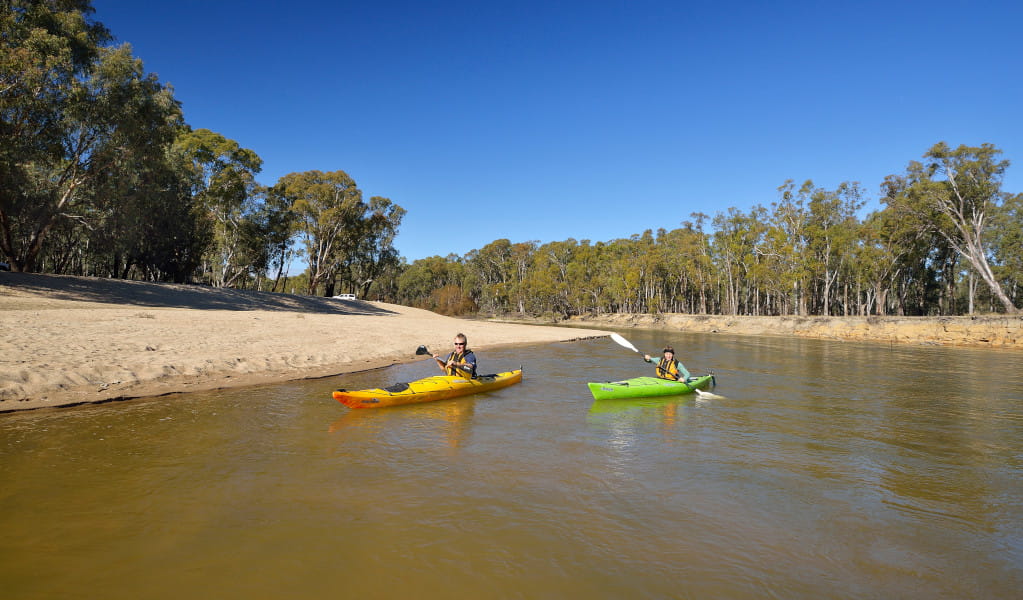Murrumbidgee Valley National Park
Overview
Murrumbidgee Valley National Park, situated along the Murrumbidgee River and near Narrandera, Hay and Balranald, is a great place for fishing, camping, kayaking, cycling, hiking and birdwatching.
Read more about Murrumbidgee Valley National Park
With few facilities and infrastructure, Murrumbidgee Valley National Park allows you freedom to find your own camping spot – as secluded or sociable as you like.
As the day breaks, grey kangaroos bound through the morning mist as you cast a line out into the river to catch a fish for breakfast. Staying at Murrumbidgee Valley National Park is the ultimate bush camping experience. Created in 2010, this national park protects part of what is now the largest continuous tract of river red gum forest in the world. There’s plenty of opportunity for fishing, swimming, picnicking, birdwatching and taking a GPS to ‘go bush’.
For those near Leeton, Turkey Flat picnic area and bird hide is a must-see. Follow it up with a walk or bike ride along Turkey Flat trail, then end the day with a swim or a paddle at Middle Beach.
Choose from cycling and hiking routes, or discover the beauty of Murrumbidgee River by canoe; for the intrepid explorer, Narrandera to Yanco weir is a four-hour paddle.
Nearby, visit Koala reserve in Murrumbidgee Valley Nature Reserve near Narrandera for a picnic, then stroll through the river red gums spotting as many koalas as you can. If travelling with your dog you cannot visit most national parks or nature reserves, but you can check out several dog-friendly locations in Murrumbidgee Regional Park.
Local alerts
For the latest updates on fires, closures and other alerts in this area, see https://www.nationalparks.nsw.gov.au/visit-a-park/parks/murrumbidgee-valley-national-park/local-alerts
Contact
- in the Murray-Riverina region
Murrumbidgee Valley National Park is always open but may have to close at times due to poor weather or fire danger.
-
-
Griffith office
02 6966 8100
Contact hours: Monday to Friday, 9am to 4pm. Closed 1pm to 2pm. - 200 Yambil Street, Griffith NSW 2680
-
Email: npws.riverina@environment.nsw.gov.au
-
Griffith office
-
-
Yanga National Park office
03 5020 1764
Contact hours: 8.30am to 4.30pm daily. - 38773 Sturt Highway, Balranald NSW 2715
-
Email: npws.lowerdarling@environment.nsw.gov.au
-
Yanga National Park office
-
-
Buronga office
03 5021 8900
Contact hours: Monday to Friday, 8.30am to 4.30pm. - 4 Melaleuca Street, Buronga NSW 2739
-
Email: npws.lowerdarling@environment.nsw.gov.au
-
Buronga office
Visitor info
All the practical information you need to know about Murrumbidgee Valley National Park.
Map

Map legend

Getting there and parking
Get driving directions
From Narrandera to Murrumbidgee Irrigation Area 1 (MIA 1):
- Travel northwest on Irrigation Way for about 12km.
- Turn left off Irrigation Way at the signpost for MIA 1.
- Follow access road in southerly direction for about 2.5km to grid.
- This is Grahams Grave entrance to MIA 1.
From Narrandera to Murrumbidgee Irrigation Area 2 (MIA 2):
- Head south along Newell Highway onto Audley Street, turning right onto Irrigation way. Continue travelling towards Leeton.
- At the entrance of Yanco, turn onto Euroley Road and travel 5km.
- Take the turn off 400m north of Euroley Bridge and after 800m cross grid where you will enter MIA2.
Parking
- McCaugheys Lagoon See on map
- Turkey Flat picnic area and bird hide See on map
Road quality
- Unsealed roads
Vehicle access
- 2WD vehicles
Weather restrictions
- Dry weather only
By bike
Check out the Bicycle information for NSW website for more information.
Best times to visit
There are lots of great things waiting for you in Murrumbidgee Valley National Park. Here are some of the highlights.
Autumn
Evenings can be balmy at this time of year, so it's still a great time to camp.
Spring
Picturesque morning mists are common at this time of year and birds and animals are most active.
Summer
Enjoy early morning and late afternoon swimming during these hotter months.
Winter
This is Murray crayfish season, and a great time to head to the river.
Weather, temperature and rainfall
Summer temperature
Average
16°C and 32°C
Highest recorded
47.7°C
Winter temperature
Average
4°C and 16.5°C
Lowest recorded
-4.8°C
Rainfall
Wettest month
May
Driest month
January
The area’s highest recorded rainfall in one day
93.3mm
Facilities
Toilets
Picnic tables
Maps and downloads
Permitted
Gathering firewood
Domestic firewood may be collected in the Yarradda collection area of Murrumbidgee Valley National Park from 1 April to 30 September with a permit. Permits are available to permanent NSW residents that live in the Riverina Bioregion and Balranald Shire. Learn more or apply for a permit.
Prohibited
Pets
Pets and domestics animals (other than certified assistance animals) are not permitted in Murrumbidgee Valley National Park. If you want to camp with your dog, find a campground in Murrumbidgee Valley Regional Park.
Smoking
NSW national parks are no smoking areas.
Nearby towns
Narrandera (28 km)
Narrandera is a Country NSW National Trust Urban Conservation Area located at the crossroads of the Newell and Sturt highways. This tranquil rural town in the heart of Riverina features tree-lined streets, fine historic buildings and many historic attractions.
Griffith (69 km)
Griffith is at the heart of the vast Murrumbidgee Irrigation Area and produces about 60% of the grapes grown in the State. Today, there are more than a dozen wineries in the district with world-famous names. Visit De Bortoli or Hanwood and stock up on local produce, such as jams, preserves or pasta sauces.
Hay (160 km)
This exciting and innovative exhibition space uses contemporary design and cutting edge technology to tell the story of Australian sheep shearing. You'll meet the shearers, shed hands, cooks, classers, cockies, sheep and dogs behind the legends at this sparkling gallery-museum in Hay.
Learn more
Murrumbidgee Valley National Park is a special place. Here are just some of the reasons why:
Wiradjuri people
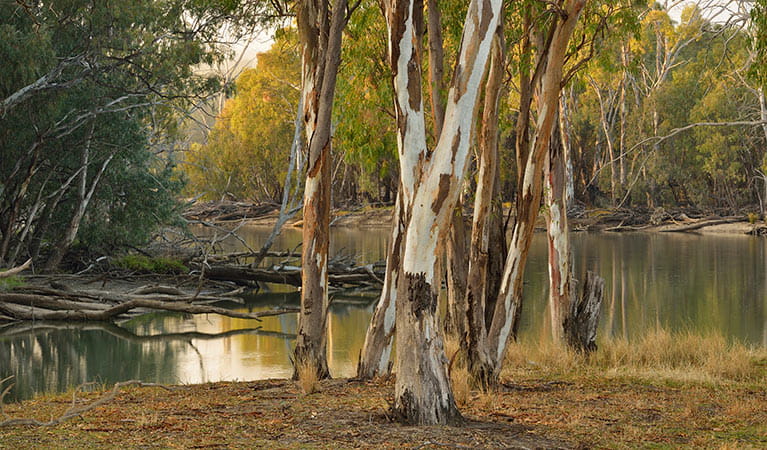
River red gums have been important to Wiradjuri people, the traditional land owners of Murrumbidgee Valley, for thousands of years. As well as being used for making canoes and shields, they also provide warmth, shelter and food. Some river red gums were large enough for individuals to sleep in, and light a small fire during the cold nights. Even today, Wiradjuri artists in Narrandera use river red gum to make boomerangs, coolamons and carved didgeridoos.
Water, water everywhere
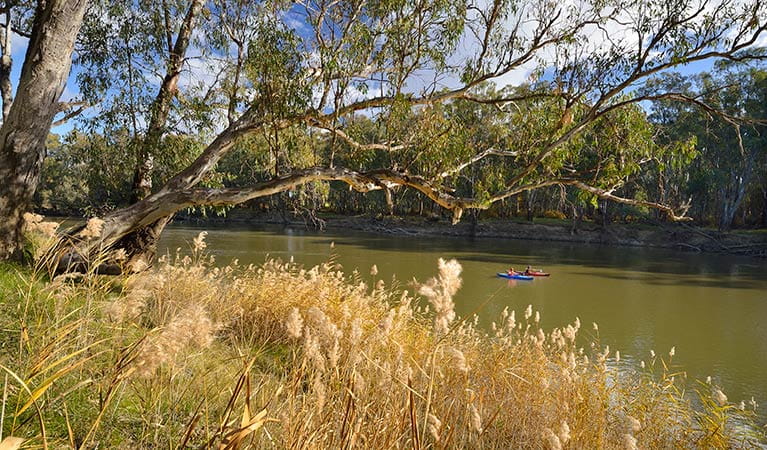
Europeans settled the area in the 1840s. By the early 1900s, private irrigation works were replaced by government projects to develop Murrumbidgee Irrigation Area (MIA). Eventually, MIA supplied water to an area of 182,000ha and enabled subdivision of grazing land into smaller units of mixed farming, horticulture, dairy and sheep. During the 1950s, Italian migrants to Australia were drawn to the area because of its similar climate and soil to Italy and became integral in the success of Riverina agriculture.
Take me to the river
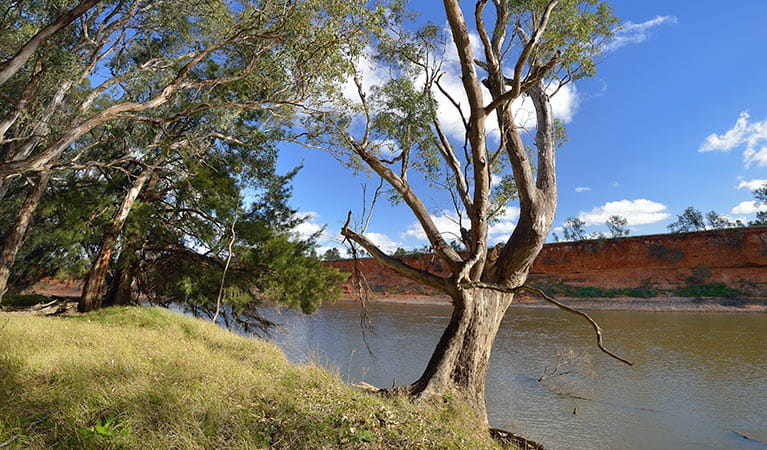
Murrumbidgee River flows in a westerly direction and is over 1,600km long. Murrumbidgee Valley national and regional parks access over 500km of river frontage at irrigation hubs of Narrandera, Yanco, Leeton, the plains of Maude and Hay, and the edge of the mallee at Balranald. River red gums benefit from times of flooding as it recharges the subsoil with water. The river supports river red gums forests, which in turn support the banks of the river with their root systems. Logged since the 1820s and managed as forests by the government since the early 1900s, in 2010 NSW National Parks and Wildlife Service protected 107,000ha of river red gums by creating new parks and reserves, which will now be enjoyed for generations to come.
- McCaugheys Lagoon McCaugheys Lagoon in Murrumbidgee Valley National Park is a great spot for birdwatching or a romantic picnic.
- Middle Beach This sandy Murrumbidgee River haven, Middle Beach, is an ideal place to go canoeing, kayaking, fishing, swimming or picnicking. Secluded camping spots can be found nearby.
River redgum
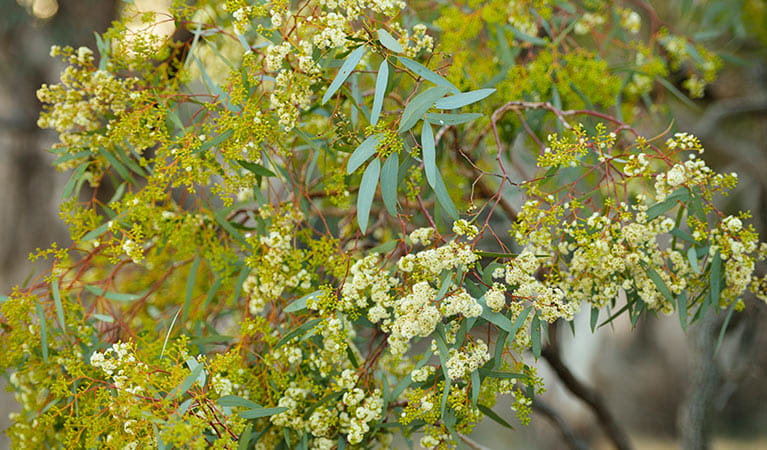
Murrumbidgee Valley National Park is synonymous with Riverina river redgum forests – an iconic Australian eucalypt which grows to awe-inspiring heights. With a deep red colour curving along rivers and channels, Riverina river red gum is of international significance. These special eucalypts provide a home to koalas, which you may spot in their branches. Bird watchers might catch a glimpse of white-bellied sea eagles, sacred kingfishers, and threatened superb parrots, amid the majestic trees. There are plenty of fishing opportunities available in the park too, with yellow belly, redfin and brim fish to catch in the area. Murrumbidgee Valley is also a sanctuary for reptiles and kangaroos.
- Forest drive If you’re looking for a scenic day trip near Murrumbidgee River, near Narrandera, go 4WDing or mountain biking along Forest drive, in Murrumbidgee Valley National Park.
- Turkey Flat picnic area and bird hide Set on Murrumbidgee River, Turkey Flat picnic area and bird hide is a great picnic spot. Visiting these NSW wetlands is a top choice for things to do in Leeton.
Plants and animals protected in this park
Animals
-

Southern boobook (Ninox novaeseelandiae)
The southern boobook, also known as the mopoke, is the smallest and most common native owl in Australia. With a musical 'boo-book' call that echoes through forests and woodlands, the southern boobook is a great one to look out for while bird watching.
-

Common ringtail possum (Pseudocheirus peregrinus)
Commonly found in forests, woodlands and leafy gardens across eastern NSW, the Australian ringtail possum is a tree-dwelling marsupial. With a powerful tail perfectly adapted to grasp objects, it forages in trees for eucalypt leaves, flowers and fruit.
-
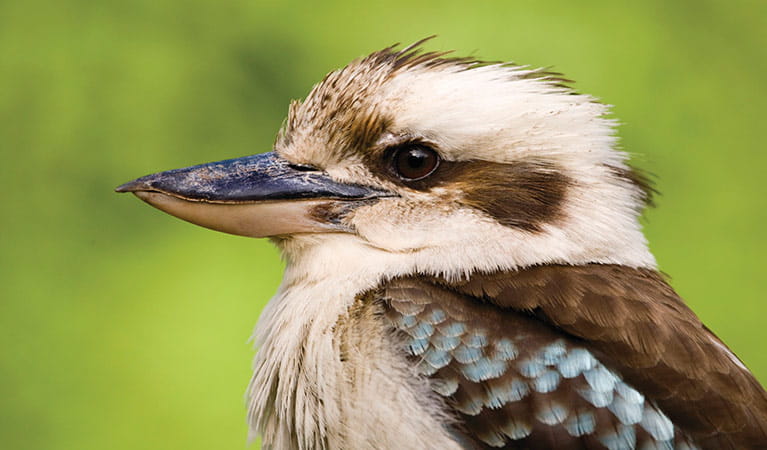
Kookaburra (Dacelo novaeguineae)
Of the 2 species of kookaburra found in Australia, the laughing kookaburra is the best-known and the largest of the native kingfishers. With its distinctive riotous call, the laughing kookaburra is commonly heard in open woodlands and forests throughout NSW national parks, making these ideal spots for bird watching.
-
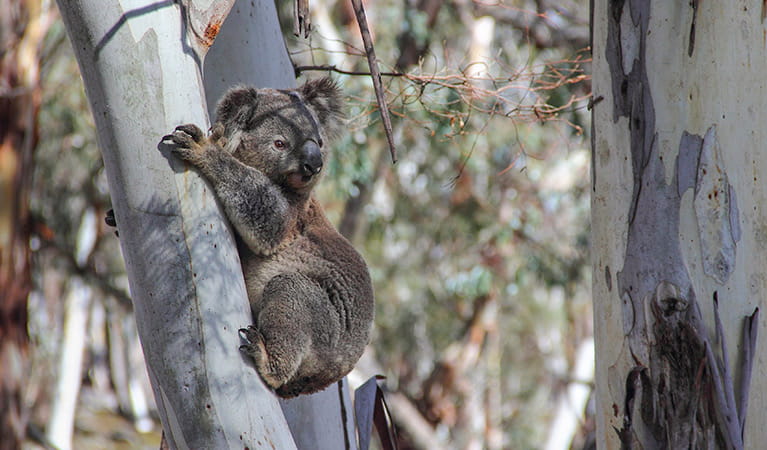
Koala (Phascolarctos cinereus)
One of the most renowned Australian animals, the tree-dwelling marsupial koala can be found in gum tree forests and woodlands across eastern NSW, Victoria and Queensland, as well as in isolated regions in South Australia. With a vice-like grip, this perhaps most iconic but endangered Australian animal lives in tall eucalypts within a home range of several hectares.
Plants
-
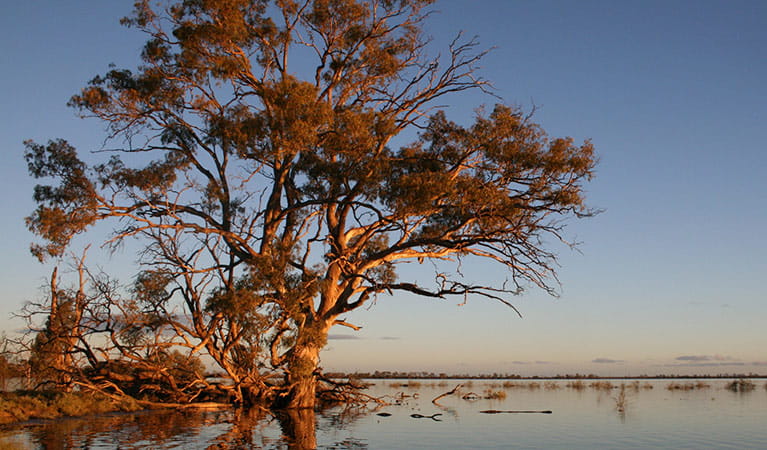
River red gum (Eucalpytus camaldulensis)
Australian native plants, majestic river red gum trees are widespread across Australian inland river systems. The river red gum is a dominant tree species of the Murray-Darling basin which spans NSW, Queensland and Victoria. This iconic native eucalypt grows to a height of 30m and is thought to have a lifespan up to 500-1000 years.
-
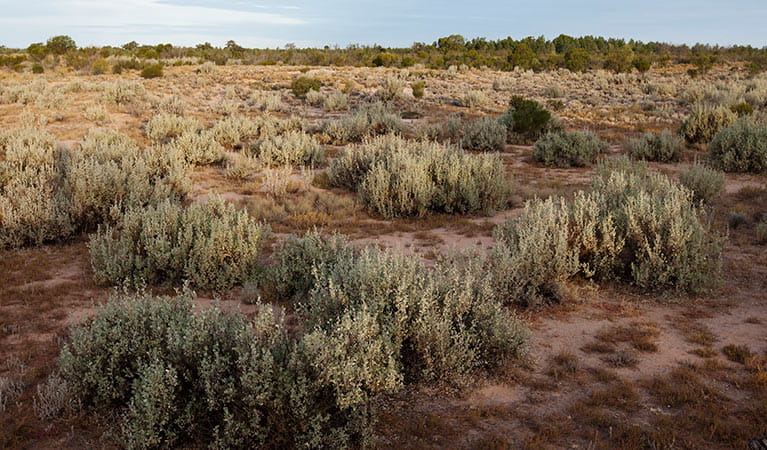
Saltbush (Atriplex nummularia)
A hardy Australian native plant, the saltbush is a small spreading shrub that can withstand dry salty soils such as those found in the desert plains of western NSW. It is grey-white in colour and has small spear-shaped succulent leaves. It flowers from December to April.
Environments in this park
Education resources (1)
What we're doing
Murrumbidgee Valley National Park has management strategies in place to protect and conserve the values of this park. Visit the OEH website for detailed park and fire management documents.
Understanding landscapes and geology
Murrumbidgee Valley National Park protects the landscapes within its borders, from its bushland to its waterways and everything in between. Management projects are in place to ensure this protection, and park infrastructure receives ongoing rehabilitation and maintenance works as required. Visitors are able to fully enjoy the park’s attractions, as the amenities surrounding them are well tended to.
Managing weeds, pest animals and other threats
Pests and weeds are a significant threat to the ecosystems within Murrumbidgee Valley National Park, and pest management is a priority for NPWS. Supplementary Pest Control takes place in Murrumbidgee Valley National Park, as well as the implementation of prioritised pest management strategies. Ongoing risk assessment for new and emerging weeds is a priority for this park to reduce the ongoing threat to this park's biodiversity values.
Developing visitor facilities and experiences
NPWS is dedicated to providing outstanding facilities and experiences for visitors to all NSW national parks. Amenities in Murrumbidgee Valley National Park, including park accommodation, tracks, trails and ramps, receive ongoing maintenance and are upgraded where required.
Conserving our Aboriginal culture
Murrumbidgee Valley National Park boasts a proud legacy of Aboriginal culture. Ongoing NPWS programs exist to access and preserve this important heritage, and NPWS fosters partnerships with local Aboriginal communities to best explore opportunities within the park and facilitate such preservation.

